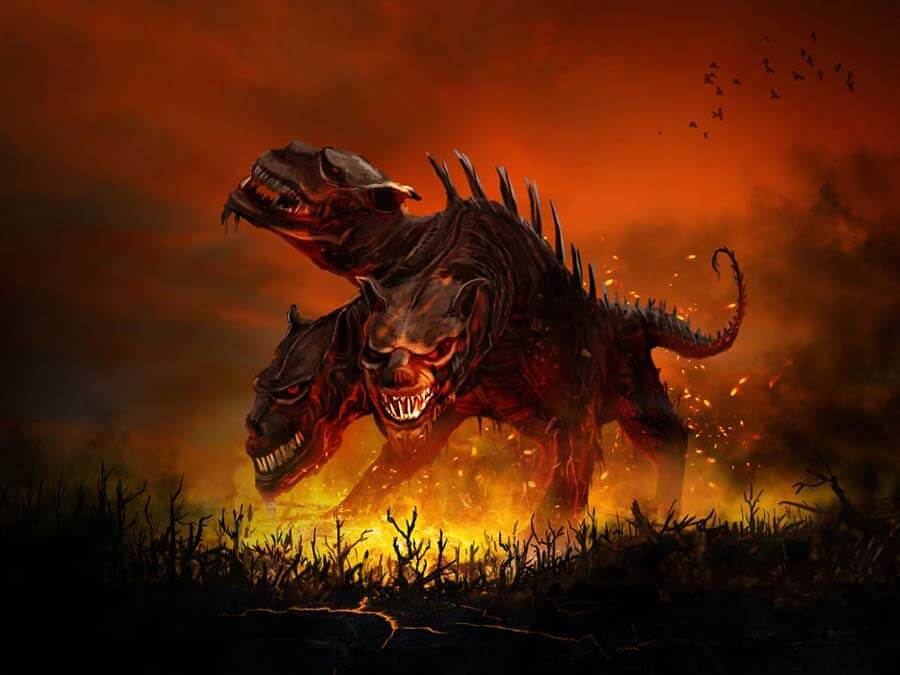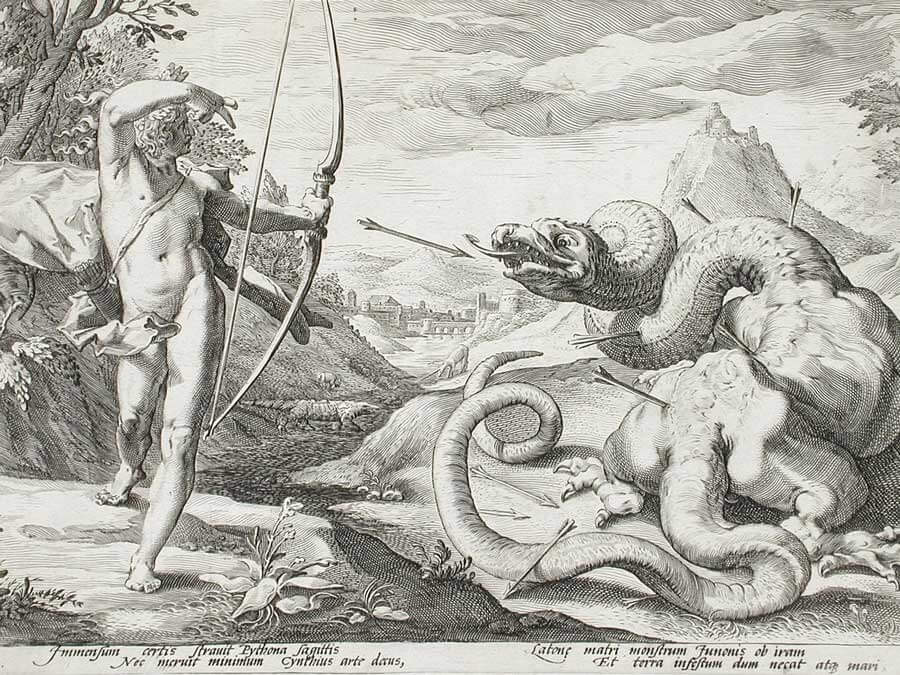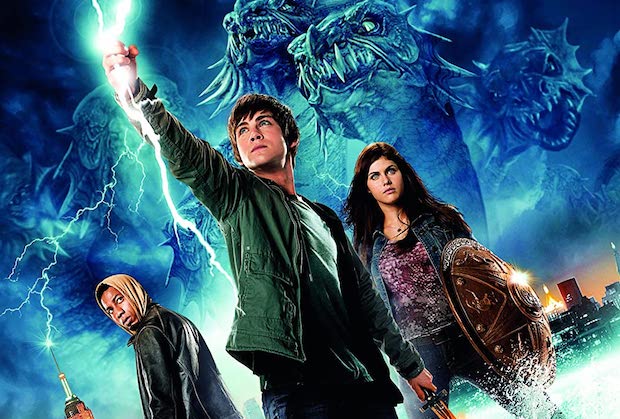1. Typhon
The “Father of all Monsters”. Typhon was the last child of Gaia, fathered by Tartarus, and is considered the most powerful and deadliest of all creatures in Greek mythology. His appearance would be accompanied by a devastating storm and his true form was thus hard to be described accurately. Some say he had a human-like upper half and others that instead of one head he had a hundred dragon heads.
His bottom half consisted of gigantic viper coils which made a hissing noise. He had huge wings and fire flashed from his eyes. Typhon was a monster that even the Olympians were afraid of. His mate was Echidna (see below), with whom he fathered many famous monsters of Greek mythology. Together, they once attacked the Olympian Gods but lost. Zeus, the King of the Olympians, confronted Typhon by throwing 100 lightning bolts on him and trapped him under Mount Etna in Sicily.

2. Echidna
The “Mother of Monsters”. Echidna was half a winged woman with glittering eyes and half a huge, scaly serpent. She had a seductive woman's face and a reptile’s body. She was immortal and used to drag her victims to earth-shattered pits where she liked to devour them alive. She was living in a cave, deep down beneath the Earth. In Greek mythology, Echidna gave birth to many famous monsters that we encounter in Greek myths. As mentioned above, her mate was the monster Typhon. After their defeat by the Olympians and the banishment of Typhon, Echidna and her offspring lived on to challenge future heroes. Echidna, like other female monsters that had the upper body of a beautiful woman and the lower body of any sort of dragon, was part of the Dracaenae (female dragon monsters). Other well-known Dracaenae were Ceto and Scylla (see further below).
![Credit: Gabriele Delhey [via wikimediacommons] The monster Echidna](/images/Blog/Monsters%20in%20Greek%20Mythology/Echidna-Greek-mythology-mother-of-all-monsters.jpg)
3. The Gorgons
The Gorgons were three deadly sisters whose hair was made of living, venomous snakes and they could turn anyone into stone just by looking into their eyes. The famous sisters were Stheno, Euryale and Medusa. Medusa is definitely the most famous and notorious among her kind. According to some accounts, she was not always a terrifying monster but a beautiful priestess at the Temple of Athena.
The God of the Seas, Poseidon, raped her and Athena punished her (since she couldn’t punish Poseidon) by turning her into that ugly creature. The Greek hero Perseus killed Medusa and used her head as a weapon to turn his enemies into stone. He later gifted it to Athena, who placed the head of Medusa on her shield.
4. Sirens
The Sirens were poultry with a female head. They were living in the seas. Their power lay in their upper body appearance: they were beautiful, young women and had a charming voice when they sang. They used their singing to lure sailors who were passing by their island and slaughter them. The great hero Odysseus (Ulysses), clever as he was, sealed his sailors' ears with wax and bound himself to the mast of his ship, to enjoy himself the beautiful song of the Sirens, without getting in the temptation of following the seductive Sirens.

5. Scylla
According to Greek mythology, Scylla was the daughter of Forky and Kitos, once a beautiful Nymph that the god Poseidon longed for. The jealous Amphitrite, Poseidon’s partner, turned her into a monster, poisoning her bathing water. She had a body of fish, a female upper torso and dog heads protruding from her neck. She haunted the rocks of a narrow strait opposite the whirlpool of another terrible monster, Charybdis (see below). In Odyssey, Odysseus’s (Ulysses) ship passes through the strait, after losing six of his men who were eaten alive by the monster.

6. Charybdis
Charybdis is another terrifying female monster in Greek mythology. She is thought to be a daughter of Poseidon and Gaia. She lived opposite Scylla, on the Asian shore of the Bosporus (a narrow, natural strait and the continental boundary between Europe and Asia). Scylla inhabited the European shore. Charybdis looked like a huge whirlpool and at its bottom, her monstrous mouth with huge, sharp teeth were waiting to devour any ship and sailors on it. Like Scylla, Charybdis is also involved in the myths of Odysseus and the Argonauts, who passed through these straits with some loss.

7. Empusa
Empusa was a demonic female monster and belonged to the villainous cult circle of the goddess of the Underworld, Hekate. She was single-legged, she wore a bronze sandal (Hekate wore bronze sandals as well) and had donkey caps. During the night, she would leave the Underworld and ascend on the world of the living. Empusa could take all forms and appeared to women and children to cause terror. She could transform herself into a bitch, a cow, or a beautiful girl. She seduced travelers, drank their blood and ate their flesh. The only way for travelers to defend themselves was to slander her.
8. Harpies
The Harpies were anthropomorphic monsters in Greek mythology, with a bird's body and a woman's head. They ‘nailed’ the souls of the people and handed over the law-breakers to the Erinyes (Furies), the three goddesses of vengeance and retribution who punished men for crimes against the natural order. When a person suddenly disappeared from the Earth, it was said that he had been carried off by the harpies to the Underworld, the Kingdom of Hades and the dead. They were agents of punishment who abducted people and tortured them on their way to the Underworld. They were vicious, cruel and violent.

9. Lamia
Lamia was a beautiful queen who ruled Libya. She fell into the disadvantage of Hera because of her relationship with Zeus. The god of thunder loved her because she was beautiful and had children with her who were killed by Hera. Because of her sadness and madness, Lamia transformed herself into a child-devouring monster. Since then, she snatches the children of other mothers out of envy. She could take her eyes out and put them back in at will.

10. Sphinx
The Sphinx has a lion's body, bird's wings and a female head. She is a treacherous and merciless monster who kills and eats those who cannot answer her riddle. This deadly version of a sphinx appears in the myth and drama of Oedipus. This Sphinx was stopping passers-by out of the Greek city of Thebes and asked them to answer her riddle, otherwise she would eat them. The riddle was: “Which creature has one voice and yet becomes four-footed and two-footed and three-footed?" in the Greek tragic play by Sophocles, the mythical King Oedipus was the only one who answered the riddle and managed to finally kill the monster. The answer he gave was: "Man - who crawls on all fours as a baby, then walks on two feet as an adult, and then uses a walking stick in old age."
![Delphi Archaeological Museum <a target='_blank' href='https://creativecommons.org/licenses/by-sa/3.0'>[CC BY-SA 3.0]</a> Statue of the Sphinx of Naxos](/images/Blog/Monsters%20in%20Greek%20Mythology/The-creature-Sphinx-in-Greek-Mythology.jpg)
11. Giants
The Giants were beings enormous in size. According to Greek mythology, they were human-like but huge in stature and irresistible in strength. Their bodies were scaly and ended up in a lizard tail. They had thick hair and a long beard. Their hairy hands held long and shiny javelins. Although they were of divine origin, they were mortal. Following other accounts, the Giants were immortals as long as they walked on the ground where they were born. They are considered to have superhuman powers, enormous size and long life, while on the contrary, they lack ethics and imagination. A famous Giant was Argus, who served as a guard of Hera.
12. Chimera
Chimera was a three-headed beast: she had a lion's body and head, a tail that ended up in a snake's head, and in the middle of her back came a goat's neck and head. Daughter of Typhon and Echidna, she could breathe fire from her mouth, according to Homer and Hesiod. Bellerophon, the great hero in Greek mythology, was the one to kill this monster, with the help of the flying horse Pegasus.

13. Lernaean Hydra
The Lernaean Hydra was another child of Typhon and Echidna, a horrible sea monster with serpentine features and many - many - snake heads. Indeed, when someone cut off one head, two others sprouted in their place. She lived in Lerna, Argolida, and spent her time torturing the world and guarding a gate to the Underworld until Heracles (Hercules) was sent to kill her and saved the region from her. To solve the problem with her heads, he would burn the beheaded neck before the two new heads sprout.

14. Mares of Diomedes
The Mares of Diomedes, also called the Mares of Thrace, were a herd of man-eating horses in Greek mythology belonging to the giant Diomedes. The Mares, which were the terror of the region of Thrace, were kept tethered by iron chains to a bronze manger and were named Podargos (the swift), Lampon (the shining), Xanthos (the yellow) and Deinos (the terrible). Heracles (Hercules) defeated these monsters in his eight labor. He fed Diomedes, their master, to his own horses and while they were occupied with their human meal, Heracles found the opportunity to bind their mouths shut.
15. Cerberus
Cerberus was the famous three-headed dog, pet of Hades, the god of the Underworld. He was standing guard at the Gates of the Underworld, making sure that no dead soul would escape and no living man would enter the realm of the dead. Besides his three terrifying heads, he also had a serpent for a tail. Only two heroes managed to defeat this monster; Heracles (Hercules) and Orpheus. Heracles managed to defeat him with his strength while Orpheus made him fall asleep with his music. Cerberus was a child of Typhon and Echidna. He had a brother from the same parents, a two-headed dog called Orthrus.

16. Nemean Lion
In Greek mythology, the Nemean Lion, was a lion living in the Nemean region, scattering fear in the area. The lion had very tough skin that could not be pierced by a weapon. He was also the offspring of Typhon and Echidna (or Orthrus and Chimera according to some other accounts). This beast was eventually killed by Heracles (Hercules) in his first of the twelve labors. Since then, the great hero wears the head of the lion on his head.

17. Stymphalian birds
The Stymphalian Birds are man-eating birds with beaks of bronze, sharp metallic feathers they could launch at their victims, and poisonous dung. According to Greek mythology, these flying creatures were brought up by the god of war, Ares, or were pets of the goddess of the hunt, Artemis. They bred quickly and swarmed over the countryside, destroying crops and terrorizing the people. Heracles (Hercules) defeated these creatures in his sixth labor by shooting arrows tipped with poisonous blood from the slain monster Lernaean Hydra.
![Painting by Albrecht Dürer (1500) [Public domain] Heracles shooting down the Stymphalian birds](/images/Blog/Monsters%20in%20Greek%20Mythology/Hercules-and-the-Stymphalian-birds.jpg)
18. Erymanthian Boar
In Greek mythology, the Erymanthian Boar was a mythical creature that took the form of a shaggy tameless boar of vast weight and foaming jaws. It would sally from the thick-wooded cypress-bearing heights of Erymanthus to harry the groves of Arcady and abuse the land of Psophis. Heracles (Hercules) was once again the hero to defeat this monster too in his fourth labor. In order to capture the boar, Heracles first chased it with shouts and thereby routed it from a certain thicket and then drove the exhausted creature into deep snow. He then trapped it and bound it in chains.
19. Minotaur
The Minotaur was born when Poseidon decided to take revenge on King Minos of Crete for his disobedience; he denied sacrificing a beautiful white bull. The god made Minos’ wife, Pasiphae, fell in love with the white male bull and sleep with him. From this union, a terrible child was born. A monster that looked like a man but had a bull's head and its strength. King Minos, not able to kill the monster and further displease Poseidon, commissioned a huge labyrinth at the basement of his palace. The great labyrinth, built by the great architect Daedalus and his son Icarus, served as a prison for the horrible creature. According to Greek mythology, the great hero Theseus entered the labyrinth and managed to kill the Minotaur and also find his way out.

20. Python
Python was a serpent monster, presided at the Delphic oracle, which existed in the cult center for its mother, Gaia. He was born by Gaia from the mud of the Flood of Deucalion with which Zeus ended the Golden Age. Python lived in a cave and protected the sanctuary of Gaia. According to Greek mythology, Apollo, a member of the Olympians’ Pantheon - the ‘new’ gods - decided to build his sanctuary in Delphi. He fought and killed the Python and thus established the famous Oracle of Delphi, the sanctuary of which can still be visited today in Greece.

21. The Colchian dragon
The Colchian dragon in Greek mythology was a fire-breathing giant serpent that guarded the Golden Fleece. The Golden Fleece was the prize the Greek hero Jason and his crew of Argonauts were after. With the help of the witch Medea, Jason managed to overcome the guarding monster and take the Fleece. It was put to sleep by the witch and it was left alone or slain by the hero.
Dragons were common creatures in Greek mythology. Besides the Colchian dragon and Python, another famous monster was Ladon. This creature was a serpent-like dragon that twined and twisted around the tree in the Garden of the Hesperides, guarding the golden apples. According to one version of the myth, the monster was killed with a bow and arrow by Heracles when he came to collect the golden apples in his eleventh labor.
There are many myths and legends about all of the above mythological monsters and creatures. Despite their obscure origins, these mythical beings of ancient Greece have their place in our heart and we hope that this applies to you all now.
See also:
About the author: Our team at Greek TravelTellers consists of academics and lovers of Greek culture. Our vision is to convey our knowledge and Greek values through unique tours and experiences. Through our blog, we hope to bring Greek history and culture closer to you. Feel free to learn more about us.





